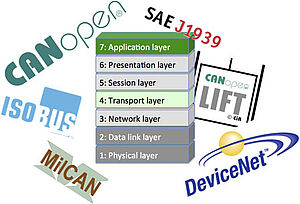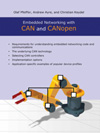Standardized higher-layer protocols

Most of the standardized CAN-based higher-layer protocol stacks implement the application layer and the transport layer also comprising some features of the presentation, session, and network layers.
The most important standardized CAN-based higher-layer protocols include:
- CANopen (CiA 301) based on Classical CAN for general embedded real-time control
- CANopen FD (CiA 1301) based on CAN FD and CAN XL for embedded real-time control with advanced features
- J1939 application profiles based on Classical CAN and CAN FD for different domains
- Devicenet profile based on Classical CAN for factory automation
The most generic higher-layer approach is CANopen. It comprises the CiA 301 application layer standardized, internationally standardized in EN 50325-4, as well as several device, interface, and application profiles (CiA 4xx series). There are also other protocol specifications for additional communication functions (CiA 3xx series). CANopen is used in many embedded and deeply embedded control applications.
To provide the broad range of CANopen users the possibility of making use of the advantages offered by CAN FD, CiA has released the CiA 1301 CANopen FD specification. Due to lengthened PDOs, CANopen FD enables the transmission of more complex process data together with further application data, e.g. relevant for condition monitoring or authentication purposes. The newly introduced Universal Service Data Object (USDO) enables meeting all communication requirements, todays and future embedded networks may be faced with. The USDO enables accessing any CANopen FD device by read- and write-access. In unicast or broadcast, any size of data can be transferred in a way that is optimized with regard to the size of the transferred data, e.g. by means of expedited, segmented or bulk transfer. The updated extended EMCY write protocol supports comprehensive diagnosis, e.g. by providing more detailed error information and a time stamp. Especially with regard to the CANopen FD network-management-related services and the internal CANopen FD device architecture, CANopen FD keeps the attributes of CANopen, so that users of CANopen can easily transfer from classic CANopen to CANopen FD.
The family of J1939-based application profiles is another higher-layer approach based on CAN lower layers. The original J1939 specifications were designed for in-vehicle networks in trucks and buses. The international Society of Automotive Engineers (SAE) develops and maintains these recommended practices. This specification series includes the J1939/21 document specifying the mapping to Classical CAN and the J1939/22 document for CAN FD mapping.
The internationally standardized ISO 11783 series (also known as Isobus), one of the J1939 derivatives, is dedicated for the communication between agriculture tractors and implements such as harvesters. It can also be used for forestry mobile machines. The IEC 61162-3 (also known as NMEA 2000) is another J1939 derivate; it is optimized for CAN-based marine navigation networks. The ISO 11992 series standardizes the communication between trucks and trailers. This J1939 derivate is a base for the European regulation of towed vehicles. Also, the ISO 16844 series standardizing tachographs uses J1939 messages for some purposes.
DIN has standardized the body builder network profile for commercial vehicles (DIN 4630). It can be mapped to J1939 or classic CANopen. This standard specifies also a generic gateway to in-vehicle networks, which is extended by DIN 14704 for fire-fighting specific functions. There is also a CANopen-based body builder sub-network for fire-fighting equipment standardized (DIN 14700).
In the passenger car industry, application layers are in general proprietary. Exceptions are the CAN transport layer and the diagnostic services, which are internationally standardized in ISO 15765-2 (transport and network layer) respectively in the ISO 14229-2 (unified diagnostic services (UDS) on CAN). Another exception is an open network for add-on devices, which is specified in the CiA 447 CANopen application profile series.
Devicenet is a further CAN-based higher-layer protocol. It was originally developed with special regard to factory automation. It comprises a broad set of profile specifications. Devicenet is internationally standardized in IEC 62026-3. The ODVA nonprofit association maintains this standard and the related profiles.

